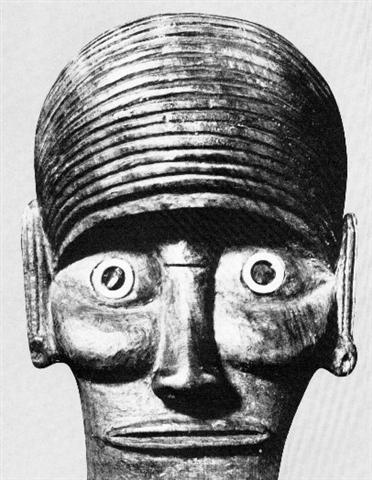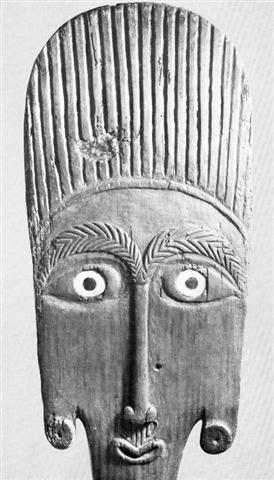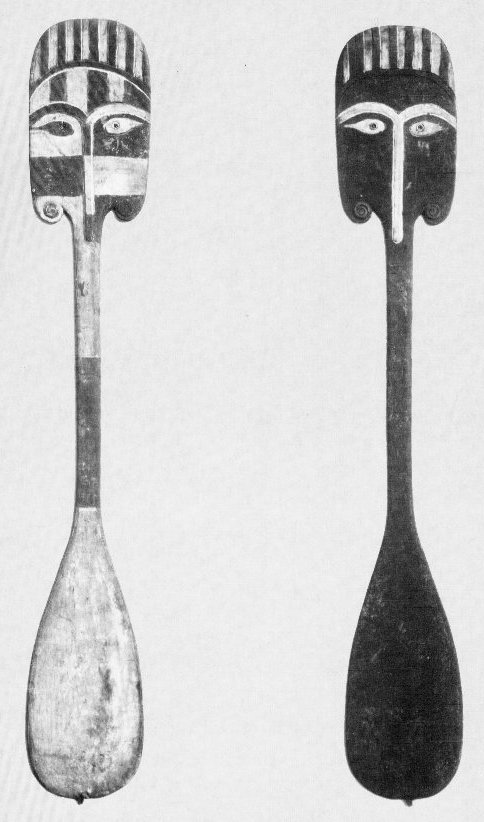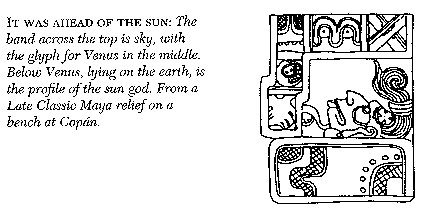|
TRANSLATIONS
Next page:
The reversed ua, I suggested, may be the flow of sunlight, though I am far from sure of it. In addition to the earlier discussion and evidence regarding this subject I wish to add one more item, viz. Sa3-121:
I do not say this glyph sequence indicates that the reversed ua in Sa3-121 means 'flow of sunlight', I just want to document this case because it ought to be usefule in a 'proof' (either way) later on. Aa6-72 and Aa6-74 (which resemble Kb3-5 at the end of the 'sun season') have a little 'sun eye' sign. I have an idea now of what it may mean. To begin with, the arching 'grooves' on the head of the ua staff - illustrating the same phenomenon we probably can see in the ua glyph type - has a weak point: I have only one example of such a staff:
I have argued for the importance of the nose (ihu) as illustrating the 'tree' holding the sky up, long in summer and short in winter, but in winter the nose does not seem to support the 'sky roof' at all: "The Classic World Trees not only lived themselves but were sources of life. Robert Carlsen and Martin Prechtel bear witness to the continuation of this understanding among the Maya of Santiago Atitlan, who live next to the crystal-blue waters of Lake AtitlŠn beneath the towering volcanoes that have shaped the highlands of Guatemala. Here is the way they describe Atiteco belief: ... before there was a world (what we would call the 'universe'), a solitary deified tree was at the center of all there was. As the world's creation approached, this deity became pregnant with potential life; its branches grew one of all things in the form of fruit. Not only were there gross physical objects like rocks, maize, and deer hanging from the branches, there were also such elements as types of lightning, and even individual segments of time. Eventually this abundance became too much for the tree to support, and the fruit fell. Smashing open, the fruit scattered their seeds; and soon there were numerous seedlings at the foot of the old tree. The great tree provided shelter for the young 'plants', nurturing them, until finally it was crowded out be the new. Since then, this tree has existed as a stump at the center of the world. This is what remains of the original 'Father/Mother' (Ti Tie Ti Tixel), the source and endpoint of life. (Carlsen and Prechtel 1991:27)." (Maya Cosmos) The 'tree stump' (Ti Tie Ti Tixel, the Snag etc) 'is' the short 'nose' in the ua staff, I think. The nose is in the middle of the face, and the flowering midsummer tree is the long nose in ao (and rapa) dance paddles, in which we can see the tree (nose) upholding the sky and creating two apartments, each inhabited with one eye:
During the night half of the day it is dark (right paddle side in the right picture), in daytime there shadows and light alternative. The eyes in the night staff are growing and descending moon, while sun sometimes shines and sometimes is far away in the daytime staff. The structure is nose in the middle with an 'eye' on each side, which we can see for instance in the Maya picture of Venus:
The 'tree stump' ua nose shows that the tree has been cut straight off (as if it was the neck of the old king Oto Uta). ... Pure O picked up a large round stone (pureva) and hit the top of the figure. Because of the stone, the neck of Oto Uta was broken. Then the wind started blowing, the billow rose, the waves broke, the rain started falling, the flame (i.e., lightning) shone brightly, and the thunder rolled ... Maybe the ua glyph type incorporates it all, not only wind, waves and rain, but also thunder and lightning. The cut off neck of the sun is also illustrated in Aa1-11:
The 'arching eyebrows' - 'wrinkles' caused by the compression from the low sky - no longer supported by the old tree, may be what we can see in the ua glyph type. Yet, there is new life to come. The little 'sun' eye (where the 'nose' - the old 'tree' - was located) indicates hope in a new generation:
The little 'sun eye' in Kb3-5 has a progenitor in the last 'eye' of Kb3-1, the only part of hakaua still alive (with perimeter intact). And suddenly we can guesse why Metoro said hakaua at this type of glyph - it causes (haka) the arrival of the ua season. There is a similar little 'sun eye' at the top of the 'canoe' in Aa6-71, and I associate to te matakao in the pair Eb4-36--37:
The fish in Aa6-73 has an upward turned moon sign at left and the fish in Eb4-36 has a downward pointing moon sign at right. In Aa6-71 the 'canoe' is a separate glyph, while in Eb4-36 the 'canoe' is the same entity as the fish. The 'sun eye' in Aa6-71 is changed into a little 'canoe' at top left in Eb4-36. Is the 'sun eye' only present at the normally oriented ua glyphs? No, I find at least one counterexample:
Some support for the ideas presented above is given by Cb12-4, where Metoro identified the right part as hua (the offspring). The 'fish' in Cb12-3 is rising and, it can be imagined, is drawn to illustrate an allusion to inverted henua ora. The 'head' lives on in the offspring, cfr Kb4-19 (one more than 18):
The 3 'sun eyes' in Cb12-1 possibly illustrate the 3 quarters of the coming year, in which case we can see the 4th quarter at bottom right in the form of a ua sign. However, the ua in Cb12-2 is reversed and the stem - of the world tree (?) - in Cb12-1 is sagging but not yet broken, i.e. the old year seems still to be living' (although 'pregnant' - the little 'sun-eye' in Cb12-2 - with the coming year). I suggest the little 'sun-eye', which sometimes can be seen in the ua glyphs, illustrate the 'nut' which has fallen from the old tree and from which a new tree (year) will grow. Next year at midsummer it will be fully grown and function to hold up the sky very high: The tip of the nose in the picture is the (double) nut in question. |
















